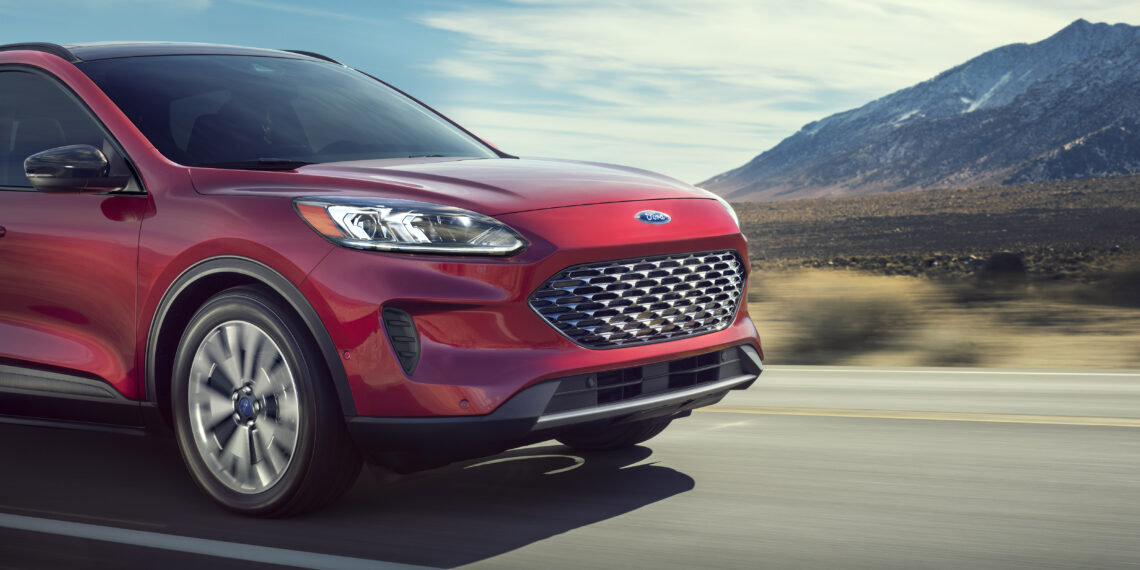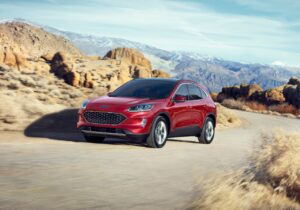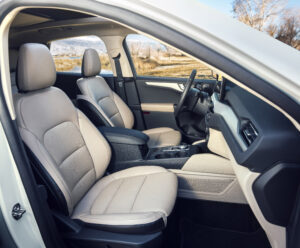
Explorer, Expedition, Escape. Enticing words for a populace that has been largely homebound over the past months. They’re also the names of a few vehicles in Ford’s SUV lineup, perfect for a socially-distanced road trip to alleviate some of that cabin fever. My family, which includes two teenagers looking for some views beyond the walls of our home and yard, tried out the Escape. Bound for Zion National Park, we loaded up the 2020 Escape SEL with all-wheel drive, and hit the road.
The drive from Phoenix to Zion is about 375 miles, and takes approximately six hours. Completely doable for a three-night vacation, but also a long enough drive that passenger and ride comfort matters. Our all-wheel drive SEL trim was equipped with Ford’s 2.0-liter EcoBoost engine, the most powerful option for the Escape, which produces 250 horsepower and is paired with an eight-speed automatic transmission. A 1.5-liter 3-cylinder EcoBoost engine, producing 180 horsepower, is the standard engine choice on S, SE, and SEL models, while the 4-cylinder 2.0-liter is an option for SEL and Titanium trims, and includes standard all-wheel drive (which is optional on all other models).
If you’re not confused yet, a hybrid engine is available as well, in an SE Sport trim, and as the standard configuration for the Titanium. There’s also a plug-in hybrid version of the Escape in SE, SEL and Titanium trims. In short, be sure to have an idea of what you’re looking for before heading to the dealership and you’ll save yourself the time and stress of having to decipher the myriad trim/engine combos on site.
 As for drive comfort, the 250-horsepower engine was more than adequate for the drive to Utah, which included some winding mountain passes and two-lane highways where passing was a breeze. It easily zipped down the scenic Mt. Carmel Highway through Zion, with its switchbacks and sweeping views. I was impressed with the quick acceleration and comfortable ride, with negligible road noise or bumps and jolts from road imperfections intruding into the cabin. Escape features five drive modes (Normal, Eco, Sport, Slippery, and Snow/Sand), with the Sport setting providing the peppiest response. However, the transmission shifts were a bit more noticeable than I’d prefer.
As for drive comfort, the 250-horsepower engine was more than adequate for the drive to Utah, which included some winding mountain passes and two-lane highways where passing was a breeze. It easily zipped down the scenic Mt. Carmel Highway through Zion, with its switchbacks and sweeping views. I was impressed with the quick acceleration and comfortable ride, with negligible road noise or bumps and jolts from road imperfections intruding into the cabin. Escape features five drive modes (Normal, Eco, Sport, Slippery, and Snow/Sand), with the Sport setting providing the peppiest response. However, the transmission shifts were a bit more noticeable than I’d prefer.
The Escape was completely redesigned for 2020, and added some nice features that improve passenger comfort. For our road trip, we were easily able to fit our luggage, along with some recreational necessities like hiking poles and (deflated) river tubes. The rear seats are adjustable, both sliding and reclining, which makes it easy to adjust for more cargo or taller passengers. For reference, both my almost-six-foot-tall son and just over five-foot-tall daughter rode comfortably in back, behind their average sized parents. Much to their chagrin, Escape doesn’t have USB ports in the back for plugging in devices.
 Up front, however, there is both a USB-A and USB-C port, with Apple CarPlay, Android Auto, and Amazon Alexa integration. Ford’s Sync 3 is standard on all but the S trim, complete with a wifi hotspot, housed in an attractive and intuitive eight-inch touchscreen on the center of the dash. While most Escape trims are well equipped – including Ford’s Co-Pilot 360 advanced safety features – the SEL trim adds niceties like leatherette sport contour bucket seats with driver’s seat memory settings, a hands-free liftgate, remote start, and reverse sensing system.
Up front, however, there is both a USB-A and USB-C port, with Apple CarPlay, Android Auto, and Amazon Alexa integration. Ford’s Sync 3 is standard on all but the S trim, complete with a wifi hotspot, housed in an attractive and intuitive eight-inch touchscreen on the center of the dash. While most Escape trims are well equipped – including Ford’s Co-Pilot 360 advanced safety features – the SEL trim adds niceties like leatherette sport contour bucket seats with driver’s seat memory settings, a hands-free liftgate, remote start, and reverse sensing system.
With the new Escape, Ford has a formidable entry in the popular small SUV segment against worthy competitors like Honda CR-V, Toyota RAV4, Nissan Rogue, and Hyundai Tucson. It has most everything buyers are looking for, including a hybrid option, safety and convenience tech that is adequate but doesn’t overwhelm, a quiet, comfortable cabin and drive, a choice of engines, and available all-wheel drive.
Vital Stats
Ford Escape is available in four trims (excluding hybrid models): S ($24,885), SE ($27,095), SEL ($29,255), and Titanium ($33,400).
Price as tested: $35,230
Fuel economy (city/highway): 27/33
What I Loved: I was impressed with the performance of the 2.0-liter EcoBoost engine, which had excellent acceleration and passing power on the road, and an impressively quiet cabin. Passenger comfort was also a plus.
What I Didn’t: No USB charging in the rear seat. Average interior styling and materials.